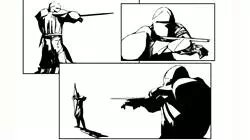University certificate
The world's largest faculty of video games”
Introduction to the Program
Art and Animation in Video Games Large companies in the video game industry need animators; you could be the solution"

The video game industry is one of the world's major audiovisual sectors. Millions of gamers spend many hours a week playing their favorite games, so the industry's leading companies have to prepare new projects on a continuous and agile basis to meet the existing demand.
The creation process of a video game involves different professionals from various fields such as scriptwriters, sound designers, project managers, etc. One of the most important figures in this process is the animator. The animator models and gives life to the different characters and visual elements that make up the video game, so it is a key element in its development.
In addition, animation is closely related to another discipline, art, which is in charge of creating and designing characters, visual concepts, establishing color codes to harmonize the aesthetics of the video game, etc. This Postgraduate diploma in Art and Animation in Video Games responds, firstly, to the demand of the industry for qualified professionals who can meet the challenges of modeling and animation in video games and, secondly, to the requirements of potential students interested in entering this sector and making a difference by producing quality animation for the new video games that are to be released on the market.
This program is, therefore, a fundamental and differential element for the preparation of future professionals in the Video Game industry, thanks to its powerful contents, created by the best professionals in the field, and to its teaching methodology, which has a strong focus on practical exercises that adequately prepare students to face professional challenges.
When you finish this degree, you will be able to animate and design characters to match your favorite video games"
This Postgraduate diploma in Art and Animation in Video Games contains the most comprehensive and up-to-date educational program on the market. Its most important features include:
- Practical cases presented by experts in Video Game Art and Animation
- The contents are broad and, at the same time, very specific, and are designed especially to provide students with specific and general knowledge of Video
- Game Animation
- Practical exercises where the self-assessment process can be carried out to improve learning
- Content that is accessible from any fixed or portable device with an Internet connection
Art and Animation are fundamental elements; specialize in the most demanded branch of the video game industry"
The program’s teaching staff includes professionals from the sector who contribute their work experience to this training program, as well as renowned specialists from leading societies and prestigious universities.
The multimedia content, developed with the latest educational technology, will provide the professional with situated and contextual learning, i.e., a simulated environment that will provide immersion training programmed to train in real situations.
This program is designed around Problem-Based Learning, whereby the professional must try to solve the different professional practice situations that arise throughout the program. For this purpose, the student will be assisted by an innovative interactive video system created by renowned and experienced experts.
If you’ve always wanted to design your own characters and bring them to life, don't wait any longer and sign up"

Learn everything you need to become a professional specialized in Video Game Animation"
Why study at TECH?
TECH is the world’s largest online university. With an impressive catalog of more than 14,000 university programs available in 11 languages, it is positioned as a leader in employability, with a 99% job placement rate. In addition, it relies on an enormous faculty of more than 6,000 professors of the highest international renown.

Study at the world's largest online university and guarantee your professional success. The future starts at TECH”
The world’s best online university according to FORBES
The prestigious Forbes magazine, specialized in business and finance, has highlighted TECH as “the world's best online university” This is what they have recently stated in an article in their digital edition in which they echo the success story of this institution, “thanks to the academic offer it provides, the selection of its teaching staff, and an innovative learning method aimed at educating the professionals of the future”
A revolutionary study method, a cutting-edge faculty and a practical focus: the key to TECH's success.
The most complete study plans on the university scene
TECH offers the most complete study plans on the university scene, with syllabuses that cover fundamental concepts and, at the same time, the main scientific advances in their specific scientific areas. In addition, these programs are continuously being updated to guarantee students the academic vanguard and the most in-demand professional skills. In this way, the university's qualifications provide its graduates with a significant advantage to propel their careers to success.
TECH offers the most comprehensive and intensive study plans on the current university scene.
A world-class teaching staff
TECH's teaching staff is made up of more than 6,000 professors with the highest international recognition. Professors, researchers and top executives of multinational companies, including Isaiah Covington, performance coach of the Boston Celtics; Magda Romanska, principal investigator at Harvard MetaLAB; Ignacio Wistumba, chairman of the department of translational molecular pathology at MD Anderson Cancer Center; and D.W. Pine, creative director of TIME magazine, among others.
Internationally renowned experts, specialized in different branches of Health, Technology, Communication and Business, form part of the TECH faculty.
A unique learning method
TECH is the first university to use Relearning in all its programs. It is the best online learning methodology, accredited with international teaching quality certifications, provided by prestigious educational agencies. In addition, this disruptive educational model is complemented with the “Case Method”, thereby setting up a unique online teaching strategy. Innovative teaching resources are also implemented, including detailed videos, infographics and interactive summaries.
TECH combines Relearning and the Case Method in all its university programs to guarantee excellent theoretical and practical learning, studying whenever and wherever you want.
The world's largest online university
TECH is the world’s largest online university. We are the largest educational institution, with the best and widest online educational catalog, one hundred percent online and covering the vast majority of areas of knowledge. We offer a large selection of our own degrees and accredited online undergraduate and postgraduate degrees. In total, more than 14,000 university degrees, in eleven different languages, make us the largest educational largest in the world.
TECH has the world's most extensive catalog of academic and official programs, available in more than 11 languages.
Google Premier Partner
The American technology giant has awarded TECH the Google Google Premier Partner badge. This award, which is only available to 3% of the world's companies, highlights the efficient, flexible and tailored experience that this university provides to students. The recognition as a Google Premier Partner not only accredits the maximum rigor, performance and investment in TECH's digital infrastructures, but also places this university as one of the world's leading technology companies.
Google has positioned TECH in the top 3% of the world's most important technology companies by awarding it its Google Premier Partner badge.
The official online university of the NBA
TECH is the official online university of the NBA. Thanks to our agreement with the biggest league in basketball, we offer our students exclusive university programs, as well as a wide variety of educational resources focused on the business of the league and other areas of the sports industry. Each program is made up of a uniquely designed syllabus and features exceptional guest hosts: professionals with a distinguished sports background who will offer their expertise on the most relevant topics.
TECH has been selected by the NBA, the world's top basketball league, as its official online university.
The top-rated university by its students
Students have positioned TECH as the world's top-rated university on the main review websites, with a highest rating of 4.9 out of 5, obtained from more than 1,000 reviews. These results consolidate TECH as the benchmark university institution at an international level, reflecting the excellence and positive impact of its educational model.” reflecting the excellence and positive impact of its educational model.”
TECH is the world’s top-rated university by its students.
Leaders in employability
TECH has managed to become the leading university in employability. 99% of its students obtain jobs in the academic field they have studied, within one year of completing any of the university's programs. A similar number achieve immediate career enhancement. All this thanks to a study methodology that bases its effectiveness on the acquisition of practical skills, which are absolutely necessary for professional development.
99% of TECH graduates find a job within a year of completing their studies.
Postgraduate Diploma in Art and Animation in Video Games
Artistic creation is a fundamental part of the production of a successful video game, which is why companies are looking for specialized professionals in the field of design who can provide a high quality service, giving the product a better final impact. In this context, the Postgraduate Diploma in Art and Animation in Video Games of TECH Global University is an excellent opportunity for all professionals interested in broadening their academic horizons and improving their work practice. Our program consists of 450 instructional hours, throughout which students will access an innovative curriculum that will allow them to learn about the different genres implemented in video games, as well as the concepts of gameplay and designs used in the production processes.
Postgraduate Diploma in Art and Animation in Video Games 100% online
This TECH program has a state-of-the-art audiovisual teaching system, thanks to this, applicants will develop different simulated case studies that will allow them to internalize easily and quickly the different concepts taught in each lesson. In addition, the resolution of this type of activities will prepare them for the different challenges they will face in the workplace. Similarly, throughout the course students will learn to handle the different software applied in the design of characters and fictional environments that can improve immersion throughout the progress of the story.







